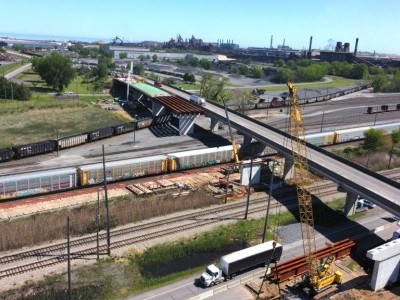High water and pandemic challenge Great Lakes-Seaway shipping, but US ports pushing through
May 21, 2020Just as the 2020 shipping season on the Great Lakes and St. Lawrence Seaway was getting underway, the COVID-19 pandemic ramped up in North America. The challenges and necessities of the pandemic are reflected in port tonnage totals for the start of the season.
“The start of the shipping season on part of the St. Lawrence Seaway was delayed for 12 days due to high-water levels on Lake Ontario,” said Bruce Burrows, President and CEO of the Chamber of Marine Commerce. “Once it was deemed safe for shipments to begin, the pandemic hit, fluctuating typical cargo needs. There has been strong demand for American wheat for worldwide bread and pasta production, but iron ore shipments slowed down in April as domestic steel production for the automotive sector declined during factory shutdowns. In our industry, it can take months before the full impacts of an economic downturn take effect, so we will be watching closely as the situation evolves over the coming weeks.”
The Port of Duluth-Superior got off to a promising start with the first ever March grain shipment. Total grain shipments through April, wheat heading mostly to Italy, topped the five-year average by 69 percent and represented a more than threefold increase season-over-season. Iron ore shipments were up 64 percent in March compared to 2019 but slowed to a 5 percent increase in April due to the pandemic and decreased demand from auto manufacturers. General cargo including dry bulk tonnage in April was 54 percent ahead of last season’s pace, led by limestone, salt and cement totals.
“Ports, seafarers and shipping companies throughout the Great Lakes are essential links in the supply chain, doing all they can to ensure the uninterrupted flow of cargo to regional and world markets,” said Jayson Hron, Director of Communications and Marketing at the Duluth Seaway Port Authority.
The Port of Toledo’s season opening tonnage numbers through April 2020 were slightly below the same period in 2019, however, the tonnage so far in 2020 was just above the same period in 2018. The Port’s first ocean vessel of the year arrived on April 4 with sugar, unloaded at Toledo’s general cargo facility operated by Midwest Terminals.
“We are optimistic that shipments through the Port of Toledo will remain steady during the 2020 shipping season and that reduced tonnage with some types of cargo will be offset by gains in other types of cargo,” said Joseph Cappel, VP of Business Development for the Toledo-Lucas County Port Authority. “So far, shipments of aluminum, fertilizer, and some bulk products, like petcoke, are all off to a good start.”
The Port of Green Bay moved nearly 228,000 tons of cargo into or out of the Port between March 15 and the end of April, which is up 19 percent from the strong 2019 shipping season. Thirteen ships moved through the Port in the first seven weeks, carrying salt from Canada, which accounted for nearly 90,000 tons of the overall total, up 43 percent from last year, while cement shipments hit 32,000 tons (+117 percent) and petroleum products topped 20,000 tons (+197 percent).
“It was good to have an early start to the shipping season with the mild weather conditions in late winter,” said Port of Green Bay Director Dean Haen. “We were cautiously optimistic heading into the shipping season with potential impacts of high-water levels and the COVID-19 pandemic. However, if these numbers carry through, this could be another strong shipping season for the port.”
The high-water levels in Lake Michigan were felt at Port Milwaukee this winter, as sporadic flooding and dock damage occurred. The Port has also remained fully operational during the pandemic and adapted its safety and security procedures to meet public health guidelines.
“Our tenants and staff are working to offer our customers safe, efficient and ongoing access to world markets despite pandemic conditions and the delayed opening of the St. Lawrence Seaway,” said Director Adam Schlicht. “Port tonnage remains consistent compared to 2019, though the long-term economic consequences of COVID-19 on domestic and international trade in the Milwaukee-Chicago region is yet to be fully revealed. I join calls for federal stimulus to support the North American economy through infrastructure projects and transportation investment at America’s Great Lakes ports. At many ports, including Milwaukee, historically high-water levels have caused sporadic flooding and dock damage, which will continue without new infrastructure improvements.”
Similar Stories

Jeffersonville port delivers record road salt shipments to Greater Louisville area during recent winter storms
View ArticleNC Ports Notice: Holiday Schedule Notice Martin Luther King Jr. Day
The Port of Wilmington Container Gate (South Gate) and the Charlotte Inland Port (CIP) will operate on a reduced schedule on Monday, January 20: 8 AM-12 PM and 1 PM-5…
View Article
Port of Long Beach’s Cordero hails ‘Green Port’ achievements
View Article
Port of San Diego accepts $5 million grant from the San Diego County Air Pollution Control District for clean air project
View Article
Adriatic Gate Container Terminal welcomes Bora Med Service
View Article
Savannah gets India cargo to market up to eight days faster
View ArticleGet the most up-to-date trending news!
SubscribeIndustry updates and weekly newsletter direct to your inbox!





